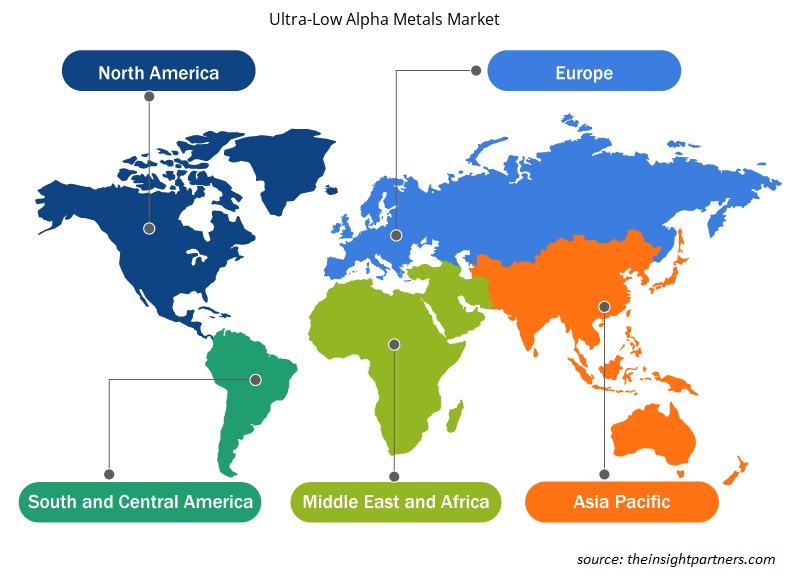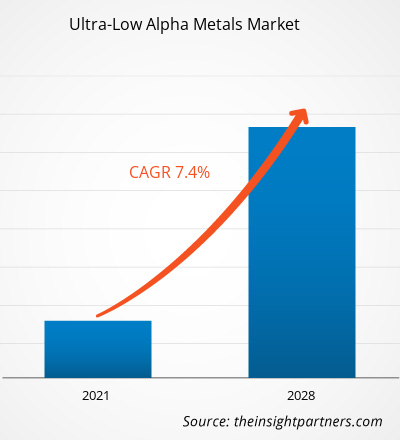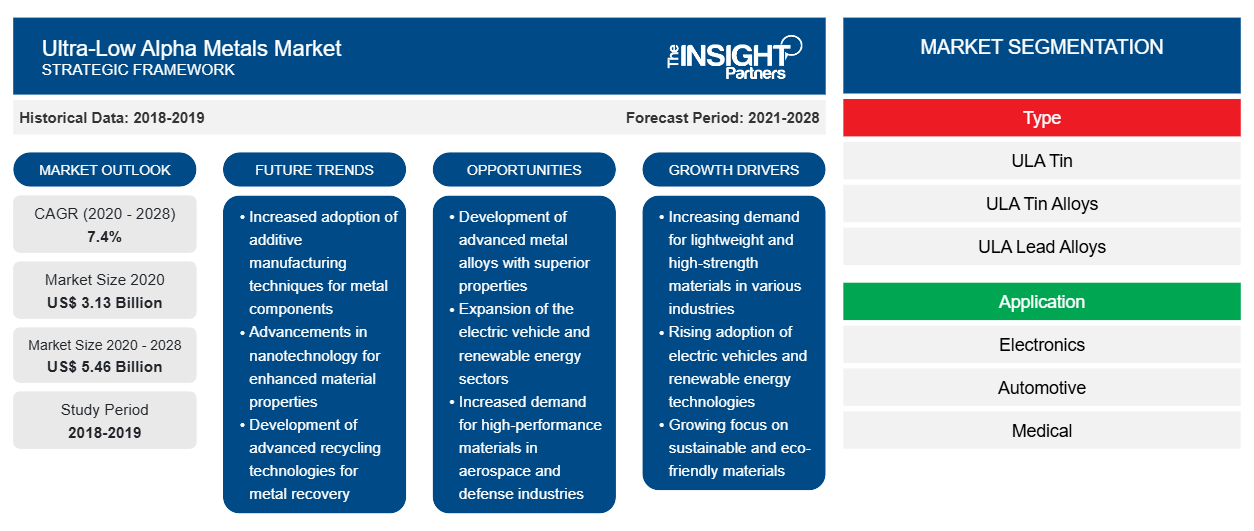[Informe de investigación] El mercado de metales de alfa ultrabajo se valoró en US$ 3.125,00 millones en 2020 y se proyecta que alcance los US$ 5.461,78 millones en 2028; se espera que crezca a una CAGR del 7,4% entre 2021 y 2028.CAGR of 7.4% from 2021 to 2028.
Los metales de alfa ultrabajo se utilizan principalmente en la soldadura por puntos en la industria electrónica. Las estrictas regulaciones gubernamentales sobre el uso de sustancias peligrosas en equipos electrónicos impulsan el crecimiento del mercado de metales de alfa ultrabajo. Sin embargo, la volatilidad de los precios de las materias primas impide el crecimiento del mercado.
En 2020, Asia Pacífico contribuyó con la mayor participación en el mercado mundial de metales de alfa ultrabajo .El crecimiento del mercado en la región se atribuye principalmente a la presencia de una sólida base industrial con importantes fabricantes. La alta demanda de metales con un contenido alfa ultrabajo en aplicaciones como la electrónica, la automoción y la medicina, respaldada por el crecimiento significativo de las bases industriales de uso final, está estimulando el crecimiento del mercado de metales con un contenido alfa ultrabajo en la región.
Personalice este informe según sus necesidades
Obtendrá personalización en cualquier informe, sin cargo, incluidas partes de este informe o análisis a nivel de país, paquete de datos de Excel, así como también grandes ofertas y descuentos para empresas emergentes y universidades.
- Obtenga las principales tendencias clave del mercado de este informe.Esta muestra GRATUITA incluirá análisis de datos, desde tendencias del mercado hasta estimaciones y pronósticos.
Impacto de la pandemia de COVID-19 en el mercado de metales de alfa ultrabajo
La actual pandemia de COVID-19 ha alterado drásticamente el estado del sector de productos químicos y materiales y ha afectado negativamente al crecimiento del mercado de metales de alfa ultrabajo. La implementación de medidas para combatir la propagación del nuevo coronavirus ha agravado la situación y ha disminuido la demanda de metales y materiales industriales. Las operaciones de las industrias se han visto afectadas en medio de la pandemia, lo que en última instancia ha perturbado el ciclo de entrega y ha aumentado los aranceles de importación y exportación. La distorsión repentina en las eficiencias operativas y las interrupciones en las cadenas de valor se atribuyen al cierre repentino de las fronteras nacionales e internacionales y al cierre temporal de las bases de fabricación debido a los bloqueos indefinidos y las cuarentenas temporales, que han obstaculizado el crecimiento del mercado durante la pandemia. Las restricciones en la cadena de suministro con volatilidad en los precios y el abastecimiento de las materias primas debido a las semanas iniciales de bloqueo han perturbado los productos y procesos industriales. Además, el enfoque en la producción justo a tiempo es otro factor preocupante que obstaculiza el crecimiento del mercado. Sin embargo, como las economías están planeando reactivar sus operaciones, se espera que la demanda de metales de alfa ultrabajo aumente a nivel mundial en los próximos años. También se espera que la creciente demanda de materiales industriales avanzados debido al crecimiento de varias industrias de uso final, como la electrónica, la aeroespacial y la defensa, la automotriz, la médica y las telecomunicaciones, impulse el crecimiento del mercado en los próximos años. Además, las inversiones significativas de los fabricantes destacados en el avance de las aleaciones sin plomo de alfa ultrabajo impulsarían el crecimiento del mercado de metales de alfa ultrabajo durante el período de pronóstico.lockdowns and temporary quarantines, which have hampered the growth of the market during the pandemic. The restrictions on supply chain with volatility in raw material pricing and sourcing due to initial weeks of lockdown have disturbed the industrial products and processes. Also, the focus on the just-in-time production is another concerning factor hindering market growth. However, as the economies are planning to revive their operations, the demand for ultra-low alpha metals is expected to rise globally in the coming years. The increasing demand for advanced industrial materials due to the growth of various end-use industries, such as electronics, aerospace & defense, automotive, medical, and telecommunication, is also expected to drive the growth of the market in the coming years. Further, significant investments by prominent manufacturers in the advancement of ultra-low alpha lead-free alloys would fuel the growth of the ultra-low alpha metals market during the forecast period.
Perspectivas del mercado
El aumento de las preocupaciones por el problema de los errores leves impulsará el crecimiento del mercado de metales con alfa ultrabajo
La creciente demanda de productos de alta densidad y bajo consumo de energía ha impulsado el concepto de reducir las dimensiones y los voltajes operativos de los dispositivos electrónicos modernos. El escalamiento constante de las tecnologías complementarias de dispositivos de metal-óxido-semiconductor ha llevado a la miniaturización y contracción del voltaje operativo de los transistores del dispositivo. Sin embargo, el concepto ha abierto nuevos desafíos, tanto desde el punto de vista de la tecnología como de los materiales. Uno de estos problemas es el error leve, el mal funcionamiento temporal del dispositivo, que es causado por la radiación de partículas alfa de alta energía. Una de las principales fuentes de radiación de partículas alfa son las soldaduras que se utilizan de manera significativa para unir componentes en el encapsulado. Por lo tanto, la creciente preocupación por el problema del error leve ha llevado a un aumento en la demanda de metales de alfa ultrabajo.
Tipo de información
Según el tipo, el mercado mundial de metales de alfa ultrabajo se segmenta en estaño ULA, aleaciones de estaño ULA, aleaciones de plomo ULA, aleaciones sin plomo ULA y otros. El segmento de aleaciones sin plomo ULA y otros lideró el mercado en 2020. Con las crecientes inversiones en actividades de investigación y desarrollo, los fabricantes están creando formas avanzadas de productos, que podrían satisfacer los requisitos específicos de la industria. De manera similar, los fabricantes han introducido aleaciones sin plomo ULA que se componen de una proporción significativamente baja de plomo (es decir, 0,1%) o nada de plomo. La demanda de aleaciones de soldadura sin plomo con alfa ultrabajo está aumentando debido a las crecientes preocupaciones por el medio ambiente.ULA tin, ULA tin alloys, ULA lead alloys, ULA lead-free alloys and others. The ULA lead-free alloys and others segment led the market in 2020. With the growing investments in research and development activities, manufacturers are coming up with the advanced forms of products, which could meet specific industry requirements. Similarly, manufacturers have introduced ULA lead-free alloys that is composed of a significantly low proportion of lead (i.e., 0.1%) or no lead at all. The demand for ultra-low alpha lead-free soldering alloys is rising due to the growing concerns toward the environment.
Información sobre aplicaciones
Según la aplicación, el mercado mundial de metales de alfa ultrabajo se segmenta en electrónica, automoción, medicina, telecomunicaciones y otros. El segmento de la electrónica lideró el mercado en 2020. Es imperativo implementar el uso de aleaciones y metales que puedan mantener un grado alfa ultrabajo cuando se utilizan en aplicaciones electrónicas. El uso de metales de alfa ultrabajo ayuda a evitar cualquier mal funcionamiento causado por errores leves en los dispositivos electrónicos. Además, la reducción significativa en el tamaño de los dispositivos, junto con la instalación de materiales de soldadura cerca de las ubicaciones sensibles en los dispositivos electrónicos, genera la necesidad de metales de alfa ultrabajo. Existe un aumento en la demanda de metales de alfa ultrabajo en la producción de productos electrónicos de consumo.
Algunos de los actores clave que operan en el mercado global de metales de alfa ultra bajo son MITSUBISHI MATERIALS Corporation; Teck Resources Limited; Advanced Manufacturing Services (AMS) Ltd; Pure Technologies; Honeywell International Inc.; DUKSAN Hi-Metal Co., Ltd; y MacDermid Alpha Electronics Solutions.
Informe Destacado
- Tendencias progresivas de la industria en el mercado de metales con niveles alfa ultra bajos para ayudar a los actores a desarrollar estrategias efectivas a largo plazo
- Estrategias de crecimiento empresarial adoptadas por los mercados desarrollados y en desarrollo
- Análisis cuantitativo del mercado de metales de alfa ultrabajo de 2019 a 2028
- Estimación de la demanda mundial de metales con contenido alfa ultrabajo
- Análisis PEST para ilustrar la eficacia de los compradores y proveedores que operan en la industria
- Avances recientes para comprender el escenario competitivo del mercado
- Tendencias y perspectivas del mercado, así como factores que impulsan y restringen el crecimiento del mercado de metales con alfa ultrabajo
- Asistencia en el proceso de toma de decisiones destacando las estrategias de mercado que sustentan el interés comercial y conducen al crecimiento del mercado.
- El tamaño del mercado de metales de alfa ultrabajo en varios nodos
- Descripción detallada y segmentación del mercado, así como la dinámica de la industria de metales de alfa ultrabajo
- Tamaño del mercado de metales con contenido alfa ultrabajo en varias regiones con oportunidades de crecimiento prometedoras
Perspectivas regionales del mercado de metales con contenido alfa ultrabajo
Los analistas de Insight Partners explicaron en detalle las tendencias y los factores regionales que influyen en el mercado de metales con niveles de alfa ultrabajos durante el período de pronóstico. Esta sección también analiza los segmentos y la geografía del mercado de metales con niveles de alfa ultrabajos en América del Norte, Europa, Asia Pacífico, Oriente Medio y África, y América del Sur y Central.

- Obtenga datos regionales específicos para el mercado de metales con contenido alfa ultrabajo
Alcance del informe sobre el mercado de metales con contenido alfa ultrabajo
| Atributo del informe | Detalles |
|---|---|
| Tamaño del mercado en 2020 | US$ 3,13 mil millones |
| Tamaño del mercado en 2028 | 5.460 millones de dólares estadounidenses |
| Tasa de crecimiento anual compuesta (CAGR) global (2020-2028) | 7,4% |
| Datos históricos | 2018-2019 |
| Período de pronóstico | 2021-2028 |
| Segmentos cubiertos | Por tipo
|
| Regiones y países cubiertos | América del norte
|
| Líderes del mercado y perfiles de empresas clave |
|
Densidad de actores del mercado de metales alfa ultrabaja: comprensión de su impacto en la dinámica empresarial
El mercado de metales con niveles ultrabajos de alfa está creciendo rápidamente, impulsado por la creciente demanda de los usuarios finales debido a factores como la evolución de las preferencias de los consumidores, los avances tecnológicos y una mayor conciencia de los beneficios del producto. A medida que aumenta la demanda, las empresas amplían sus ofertas, innovan para satisfacer las necesidades de los consumidores y aprovechan las tendencias emergentes, lo que impulsa aún más el crecimiento del mercado.
La densidad de actores del mercado se refiere a la distribución de las empresas o firmas que operan dentro de un mercado o industria en particular. Indica cuántos competidores (actores del mercado) están presentes en un espacio de mercado determinado en relación con su tamaño o valor total de mercado.
Las principales empresas que operan en el mercado de metales con contenido alfa ultrabajo son:
- Corporación de materiales Mitsubishi
- Recursos Teck Limitados
- Servicios de fabricación avanzada (AMS) Ltd.
- Tecnologías puras
- Compañía: Honeywell International Inc.
Descargo de responsabilidad : Las empresas enumeradas anteriormente no están clasificadas en ningún orden particular.

- Obtenga una descripción general de los actores clave del mercado de metales alfa ultrabajos
Mercado mundial de metales de alfa ultrabajo
Por tipo
- Lata de ULA
- Aleaciones de estaño ULA
- Aleaciones de plomo ULA
- Aleaciones sin plomo ULA y otras
Por aplicación
- Electrónica
- Automotor
- Médico
- Telecomunicación
- Otros.
Perfiles de empresas
- Corporación MITSUBISHI MATERIALS
- Recursos Teck Limitados
- Servicios de fabricación avanzada (AMS) Ltd.
- Tecnologías puras
- Compañía: Honeywell International Inc.
- DUKSAN Hi-Metal Co., Ltd
- Soluciones electrónicas MacDermid Alpha
- Análisis histórico (2 años), año base, pronóstico (7 años) con CAGR
- Análisis PEST y FODA
- Tamaño del mercado, valor/volumen: global, regional y nacional
- Industria y panorama competitivo
- Conjunto de datos de Excel
Informes recientes
Testimonios
Razón para comprar
- Toma de decisiones informada
- Comprensión de la dinámica del mercado
- Análisis competitivo
- Información sobre clientes
- Pronósticos del mercado
- Mitigación de riesgos
- Planificación estratégica
- Justificación de la inversión
- Identificación de mercados emergentes
- Mejora de las estrategias de marketing
- Impulso de la eficiencia operativa
- Alineación con las tendencias regulatorias























 Obtenga una muestra gratuita para - Mercado de metales con niveles alfa ultra bajos
Obtenga una muestra gratuita para - Mercado de metales con niveles alfa ultra bajos